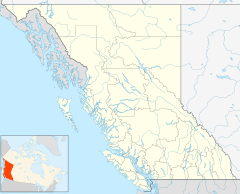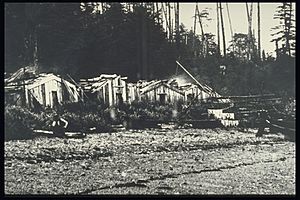Dadens facts for kids
Quick facts for kids
Dadens
|
|
|---|---|
|
Village
|
|
| Country | |
| Province | BC/BCE |
| Government | |
| • Body | Haida Nation |
Dadens (pronounced daa.adans) is a historic village on the southern coast of Langara Island (called K'íis Gwáayaay in the Haida language). It belongs to the Haida Nation on the Haida Gwaii islands in British Columbia, Canada. Early European settlers sometimes called it Tartenee or Tatense. It was also known as Tatense Reserve 16 under some old government rules.
Dadens was a very important trading spot in the late 1700s. European traders came here to trade for furs. This was because the village was large and easy to reach. Today, families do not live in Dadens all year. But it was a busy fishing village in the summer until the 1950s and 1960s. Some Haida still use it a little bit today. Over time, some families from Dadens moved to Southeast Alaska. These people are now known as the Kiagani Haida.
Contents
Who Lived in Dadens?
Haida families traditionally belong to one of two main groups, called moieties or clans. These are the Eagle and the Raven clans. Each family group also has its own special history and symbols, called crests. This was a common practice for the Haida in the past. Not all Haida people follow this practice today.
According to a book by George F. MacDonald, Dadens was owned by the Middle Town People. This group was part of the Yahgu Laanaas Raven Clan. This was true when Europeans first arrived in the area.
European Visitors and Fur Trade
Early Encounters
The first time Dadens was mentioned in writing was in 1774. Explorer Juan Perez sailed past it, but he did not name it. The first recorded landing at Dadens happened in 1789. This was done by Captain William Douglas. When Captain Douglas arrived, he did not have much success trading. This was because the iron he brought was not very good quality. Records from that time show Dadens was still a fairly large village. Many people lived there.
John Bartlett visited the village in 1791. He made the first known drawing of a house and a tall pole from Dadens. Another explorer, John Meares, had also seen a pole in 1789. Joseph Ingraham also landed in Dadens in 1791. He wrote in his journal about the village and its poles. He met three chiefs there. He named two of them as gu.uu (also called Cow) and Goi. He did not record the name of the third chief.
Ingraham's journal was the first to describe two large poles. Both were about four storeys tall. It is not clear what the second pole represented. He also described a house with a "dug-out inside" and strong support planks. Soon after, the first French ship arrived. It was captained by Etienne Marchand. An officer on his ship saw people in canoes going ashore. The ship quickly followed them. At this time, only two houses were left in the village. But many people still lived in them.
Eight years later, Captain James Rowan arrived on his ship Eliza. He traded a hostage with the people of Dadens. This was to make sure there was peace between the two groups. The ship's clerk, Samuel Berling, wrote down what the hostage, 'Mr. Bumstead,' saw. There were still only two houses standing. But Berling said a surprisingly large number of people lived in them. He said many of them were female slaves. Here, he met Yaahl Daajee, the chief. Berling wrote his name as 'Altatse.' Another source calls him Eldarge. According to this journal, the two houses belonged to this chief and his brother. The brother's name was not written down.
Moving to Alaska
The Kaigani Haida
Over time, some Haida families from Dadens moved to Southeast Alaska. This happened many times in Haida history. Experts believe some of these families moved after Europeans arrived. Florence Davidson, in her book During My Time, remembers gatherings at Dadens in the 1900s.
The Haida who moved to Alaska became known as the Alaskan Haida, or Ñ'íis Ýaat'áay. People also called them the Kaigani Haida. The Tlingit Peoples also live in Alaska. Today, these two groups have joined together for political reasons. They want to protect their traditional lands. They also want to be recognized as independent nations. They work together under the Central Council Tlingit and Haida Indian Tribes of Alaska. On Haida Gwaii, the Council of the Haida Nation (CHN) is the main Indigenous government.
Dadens Today
Dadens is not lived in today. But the Haida people have not forgotten it. There are still hereditary chiefs for the village. This title is passed down through the mother's family line. These chiefs do not live in Dadens. But they are responsible for protecting it.
The current hereditary chief is Darin Swanson. His Haida name is Ginaawaan. He is a respected Chief and a member of the Hereditary Chiefs Council. This council is another important governing body, along with the CHN.
Another important chief was Claude Davidson (1924-1991). He was the son of Florence Davidson. Claude was an artist and the father of Robert Davidson and Reg Davidson. Both of his sons are also famous artists. Claude was chief from 1986 until he passed away.
Today, a Watchman protects the village. To visit Dadens, like all historic villages in Haida Gwaii, you need to get a permit first.



